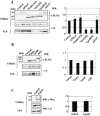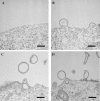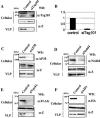Cellular factors required for Lassa virus budding
- PMID: 16571837
- PMCID: PMC1440458
- DOI: 10.1128/JVI.80.8.4191-4195.2006
Cellular factors required for Lassa virus budding
Abstract
It is known that Lassa virus Z protein is sufficient for the release of virus-like particles (VLPs) and that it has two L domains, PTAP and PPPY, in its C terminus. However, little is known about the cellular factor for Lassa virus budding. We examined which cellular factors are used in Lassa virus Z budding. We demonstrated that Lassa Z protein efficiently produces VLPs and uses cellular factors, Vps4A, Vps4B, and Tsg101, in budding, suggesting that Lassa virus budding uses the multivesicular body pathway functionally. Our data may provide a clue to develop an effective antiviral strategy for Lassa virus.
Figures



Similar articles
-
Overlapping motifs (PTAP and PPEY) within the Ebola virus VP40 protein function independently as late budding domains: involvement of host proteins TSG101 and VPS-4.J Virol. 2003 Feb;77(3):1812-9. doi: 10.1128/jvi.77.3.1812-1819.2003. J Virol. 2003. PMID: 12525615 Free PMC article.
-
Budding of PPxY-containing rhabdoviruses is not dependent on host proteins TGS101 and VPS4A.J Virol. 2004 Mar;78(6):2657-65. doi: 10.1128/jvi.78.6.2657-2665.2004. J Virol. 2004. PMID: 14990685 Free PMC article.
-
The functionally exchangeable L domains in RSV and HIV-1 Gag direct particle release through pathways linked by Tsg101.Traffic. 2005 Oct;6(10):880-94. doi: 10.1111/j.1600-0854.2005.00323.x. Traffic. 2005. PMID: 16138902 Free PMC article.
-
[Role of ESCRT in virus budding].Tanpakushitsu Kakusan Koso. 2008 Dec;53(16 Suppl):2251-6. Tanpakushitsu Kakusan Koso. 2008. PMID: 21038617 Review. Japanese. No abstract available.
-
[Autophagy in mammalian cells--enter actors].Seikagaku. 2001 Sep;73(9):1154-9. Seikagaku. 2001. PMID: 11676000 Review. Japanese. No abstract available.
Cited by
-
Viral and cellular requirements for the budding of feline endogenous retrovirus RD-114.Virol J. 2011 Dec 14;8:540. doi: 10.1186/1743-422X-8-540. Virol J. 2011. PMID: 22168342 Free PMC article.
-
The z protein of the new world arenavirus tacaribe virus has bona fide budding activity that does not depend on known late domain motifs.J Virol. 2009 Dec;83(23):12651-5. doi: 10.1128/JVI.01012-09. Epub 2009 Sep 16. J Virol. 2009. PMID: 19759156 Free PMC article.
-
Efficient budding of the tacaribe virus matrix protein z requires the nucleoprotein.J Virol. 2010 Apr;84(7):3603-11. doi: 10.1128/JVI.02429-09. Epub 2010 Jan 27. J Virol. 2010. PMID: 20106925 Free PMC article.
-
Autophagy Promotes Infectious Particle Production of Mopeia and Lassa Viruses.Viruses. 2019 Mar 23;11(3):293. doi: 10.3390/v11030293. Viruses. 2019. PMID: 30909570 Free PMC article.
-
The Lymphocytic Choriomeningitis Virus Matrix Protein PPXY Late Domain Drives the Production of Defective Interfering Particles.PLoS Pathog. 2016 Mar 24;12(3):e1005501. doi: 10.1371/journal.ppat.1005501. eCollection 2016 Mar. PLoS Pathog. 2016. PMID: 27010636 Free PMC article.
References
-
- Bouamr, F., J. A. Melillo, M. Q. Wang, K. Nagashima, M. de Los Santos, A. Rein, and S. P. Goff. 2003. PPPYVEPTAP motif is the late domain of human T-cell leukemia virus type 1 Gag and mediates its functional interaction with cellular proteins Nedd4 and Tsg101. J. Virol. 77:11882-11895. - PMC - PubMed
-
- Cao, W., M. D. Henry, P. Borrow, H. Yamada, J. H. Elder, E. V. Ravkov, S. T. Nichol, R. W. Compans, K. P. Campbell, and M. B. Oldstone. 1998. Identification of alpha-dystroglycan as a receptor for lymphocytic choriomeningitis virus and Lassa fever virus. Science 282:2079-2081. - PubMed
-
- Dong, X., H. Li, A. Derdowski, L. Ding, A. Burnett, X. Chen, T. R. Peters, T. S. Dermody, E. Woodruff, J. J. Wang, and P. Spearman. 2005. AP-3 directs the intracellular trafficking of HIV-1 Gag and plays a key role in particle assembly. Cell 120:663-674. - PubMed
-
- Eichler, R., T. Strecker, L. Kolesnikova, J. ter Meulen, W. Weissenhorn, S. Becker, H. D. Klenk, W. Garten, and O. Lenz. 2004. Characterization of the Lassa virus matrix protein Z: electron microscopic study of virus-like particles and interaction with the nucleoprotein (NP). Virus Res. 100:249-255. - PubMed
-
- Garrus, J. E., U. K. von Schwedler, O. W. Pornillos, S. G. Morham, K. H. Zavitz, H. E. Wang, D. A. Wettstein, K. M. Stray, M. Cote, R. L. Rich, D. G. Myszka, and W. I. Sundquist. 2001. Tsg101 and the vacuolar protein sorting pathway are essential for HIV-1 budding. Cell 107:55-65. - PubMed
Publication types
MeSH terms
Substances
LinkOut - more resources
Full Text Sources
Other Literature Sources
Molecular Biology Databases

